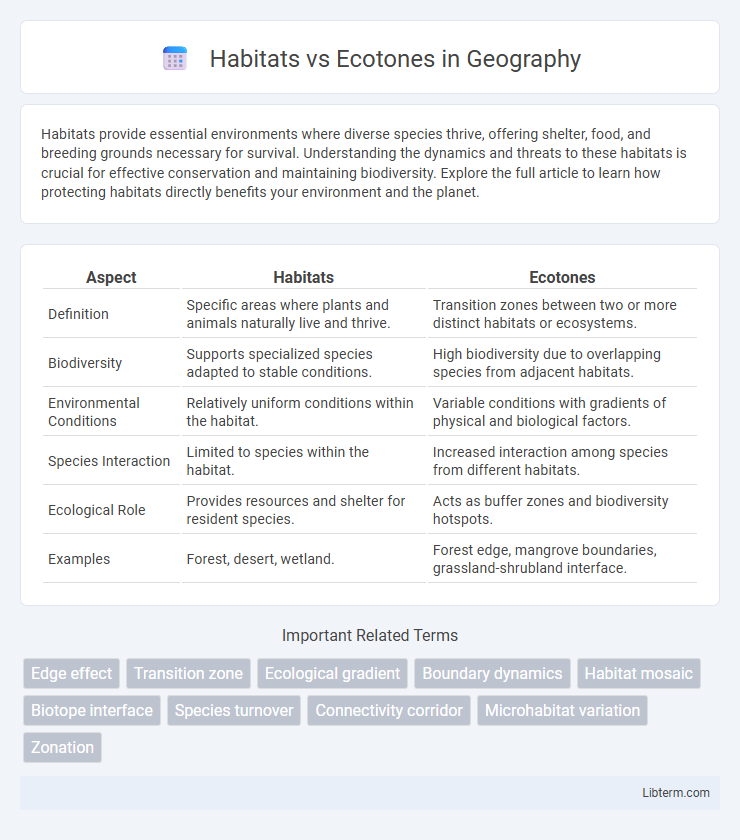Habitats provide essential environments where diverse species thrive, offering shelter, food, and breeding grounds necessary for survival. Understanding the dynamics and threats to these habitats is crucial for effective conservation and maintaining biodiversity. Explore the full article to learn how protecting habitats directly benefits your environment and the planet.
Table of Comparison
| Aspect | Habitats | Ecotones |
|---|---|---|
| Definition | Specific areas where plants and animals naturally live and thrive. | Transition zones between two or more distinct habitats or ecosystems. |
| Biodiversity | Supports specialized species adapted to stable conditions. | High biodiversity due to overlapping species from adjacent habitats. |
| Environmental Conditions | Relatively uniform conditions within the habitat. | Variable conditions with gradients of physical and biological factors. |
| Species Interaction | Limited to species within the habitat. | Increased interaction among species from different habitats. |
| Ecological Role | Provides resources and shelter for resident species. | Acts as buffer zones and biodiversity hotspots. |
| Examples | Forest, desert, wetland. | Forest edge, mangrove boundaries, grassland-shrubland interface. |
Introduction to Habitats and Ecotones
Habitats are specific environments where particular plant and animal species live, providing essential resources like food, shelter, and breeding grounds. Ecotones represent transitional zones between adjacent habitats, characterized by a mix of species from both areas and often higher biodiversity. These zones play a crucial role in ecological dynamics by supporting unique species interactions and serving as indicators of environmental change.
Defining Habitats: Core Concepts
Habitats refer to the specific natural environments where particular species or communities live, characterized by consistent physical and biological conditions essential for their survival and reproduction. Core concepts defining habitats include available resources, climatic conditions, and spatial structure that support the existence of flora and fauna populations. Understanding habitat parameters such as soil type, moisture levels, and temperature regimes enables accurate ecosystem classification and conservation planning.
Ecotones: The Transitional Zones Explained
Ecotones are transitional zones where two or more distinct habitats or ecosystems converge, creating unique environmental conditions and high biodiversity. These areas often possess species from adjoining habitats as well as specialized organisms adapted to the dynamic ecological gradients. Ecotones play crucial roles in ecological processes, serving as indicators of environmental change and supporting enhanced biological productivity and species interactions.
Key Differences Between Habitats and Ecotones
Habitats are specific environments where particular species live, characterized by relatively uniform conditions and stable resources. Ecotones serve as transition zones between two distinct habitats, exhibiting higher biodiversity and more complex interactions due to the mixing of species from adjacent areas. Unlike habitats, ecotones display increased environmental gradient variability, creating unique ecological niches and greater species richness.
Ecological Importance of Habitats
Habitats provide essential resources such as food, shelter, and breeding grounds that support biodiversity and maintain ecosystem stability. They serve as natural environments for species interactions, nutrient cycling, and energy flow critical to ecological balance. Protecting diverse habitats ensures resilience against environmental changes and preserves genetic diversity crucial for adaptation.
Ecotones and Biodiversity Hotspots
Ecotones, transitional zones between distinct habitats, exhibit heightened biodiversity due to the convergence of species from adjacent ecosystems and unique environmental conditions that support specialized organisms. These areas often serve as biodiversity hotspots, harboring rare and endemic species and enhancing ecological resilience by facilitating species interactions and genetic exchange. Conservation efforts targeting ecotones are critical for preserving biodiversity, as these dynamic interfaces are vulnerable to habitat fragmentation and climate change impacts.
Species Adaptation in Habitats vs Ecotones
Species adaptation in habitats involves gradual specialization to consistent environmental conditions, promoting niche stability and long-term survival. In ecotones, species exhibit greater phenotypic plasticity and genetic diversity due to transitional environmental gradients, enabling rapid responses to variable or unstable conditions. These adaptive strategies in ecotones enhance biodiversity by supporting both habitat specialists and generalists.
Human Impacts on Habitats and Ecotones
Human activities such as urbanization, deforestation, and agriculture significantly alter habitats and ecotones, leading to habitat fragmentation and biodiversity loss. Ecotones, being transitional zones between habitats, are particularly sensitive to changes in land use and pollution, which disrupt species interactions and ecosystem services. Conservation efforts must address these impacts by promoting habitat connectivity and protecting ecotonal regions to maintain ecological balance and resilience.
Conservation Strategies for Habitats and Ecotones
Conservation strategies for habitats emphasize preserving biodiversity hotspots by protecting core areas and managing human activities to maintain ecosystem integrity. Ecotones require targeted efforts to safeguard transition zones where species from adjacent habitats interact, promoting genetic exchange and enhancing resilience. Prioritizing buffer zones and connectivity corridors facilitates species migration and adaptive responses to environmental changes in both habitats and ecotones.
Future Perspectives on Habitat and Ecotone Research
Future perspectives on habitat and ecotone research emphasize integrating advanced remote sensing technologies with eco-informatics to monitor spatial and temporal dynamics at fine scales. Predictive modeling incorporating climate change scenarios aims to understand shifts in ecotone boundaries and habitat connectivity, crucial for biodiversity conservation strategies. Innovative interdisciplinary approaches combining genomics, landscape ecology, and socio-ecological systems are set to enhance adaptive management and restoration efforts in rapidly changing environments.
Habitats Infographic

 libterm.com
libterm.com